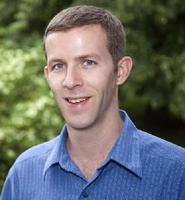
Dickinson College professor David Richeson '93 was awarded the Mathematical Association of America’s 2010 Euler Book Prize for his book “Euler’s Gem: The Polyhedron Formula and the Birth of Topology.”
Each year the prize is awarded to the author of an outstanding book about mathematics, based on clarity of exposition and the degree to which it promises to enhance and enrich the public’s view of mathematics. The Mathematical Association of America is the largest professional society that focuses on undergraduate mathematics.
“Euler’s Gem” tells the story of an elementary formula for cubes, pyramids, buckyballs, and other polyhedra that eluded the world’s greatest mathematicians for millennia. Its discovery by the eminent mathematician Leonhard Euler in 1750 (who also happens to be the namesake of the book prize) marked the birth topology, a field of mathematics that is still making headlines today. In one survey of mathematicians, Euler’s formula was voted the second most beautiful theorem in mathematics.
“Previous attempts to explain the beauty of this simple formula and to explore its depth... pale by comparison to Richeson’s extraordinary narrative,” the judging committee said, adding that “Euler’s Gem” is “elegant, concise and surprising,” featuring descriptions that are “amazingly friendly” and prose that is “a joy to read.”
That joy stems from the author’s passion for his subject.
“There is so much beautiful mathematics that most people never see — Euler's formula is a prime example,” said Richeson. “It is simple enough to explain to a child, yet it may not be seen until graduate school. It is especially wonderful because it is straightforward, yet has deep meaning and many important mathematical consequences.”
The book is an Amazon.com best-seller—a noteworthy achievement for an academic work by a first-time author. The book appeals both to professional mathematicians and to readers Richeson describes as “mathematical enthusiasts.” The latter group includes motivated high-school students, college students and others who want to deepen their understanding of mathematics as well as readers who simply want to learn something new.
“I spent a lot of time thinking about how to write about advanced topics in a way that someone with no background could understand,” he said.
Charles Ashbacher, in a review for “Journal of Recreational Mathematics,” said, “This is an excellent book about a great man and a timeless formula.” “Choice” magazine said Richeson “has achieved a remarkable feat, introducing a naïve reader to a rich history without compromising the insights and without leaving out a delicious detail.”
The book is beautifully illustrated with 185 diagrams to supplement the text.
Richeson is an associate professor at Dickinson College and chair of the Department of Mathematics and Computer Science. He earned a bachelor’s degree in mathematics from Hamilton College and a master’s degree and Ph.D. in mathematics from Northwestern University. He has over 20 publications in diverse areas such as topology, dynamical systems, the history of mathematics, and mathematics pedagogy. He writes regularly on his blog, Division by Zero, http://divisbyzero.com/.
For more information call 717-245-1413 or visit:
http://www.dickinson.edu/academics/programs/mathematics-and-computer-science/
Contact: Media Relations, Dickinson College
media@dickinson.edu; 717-245-1289
Posted February 22, 2010
